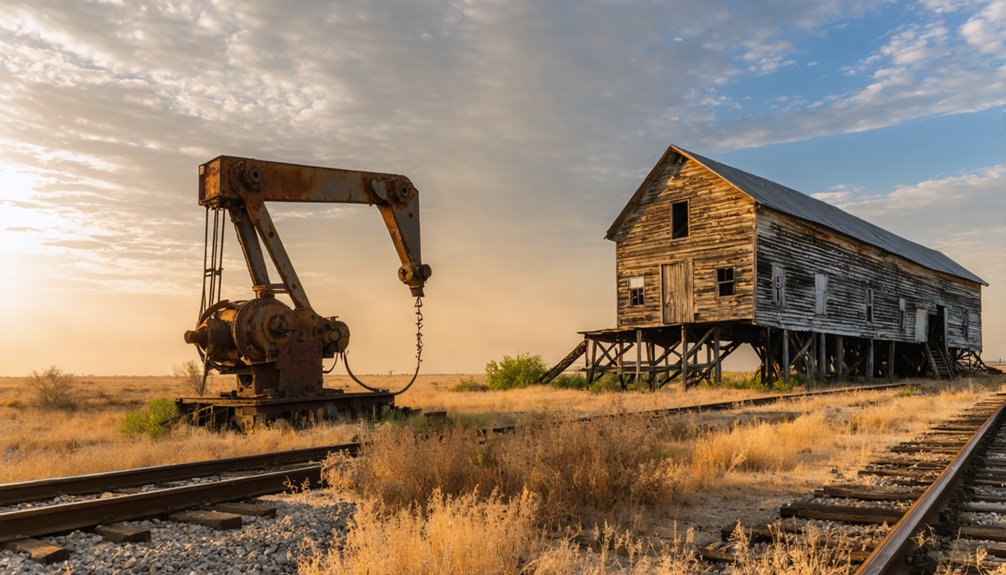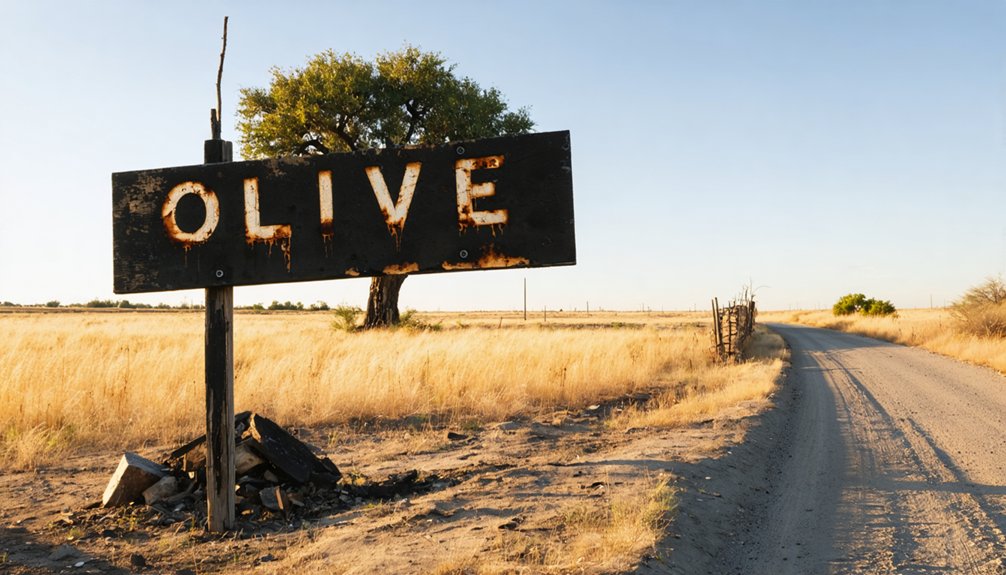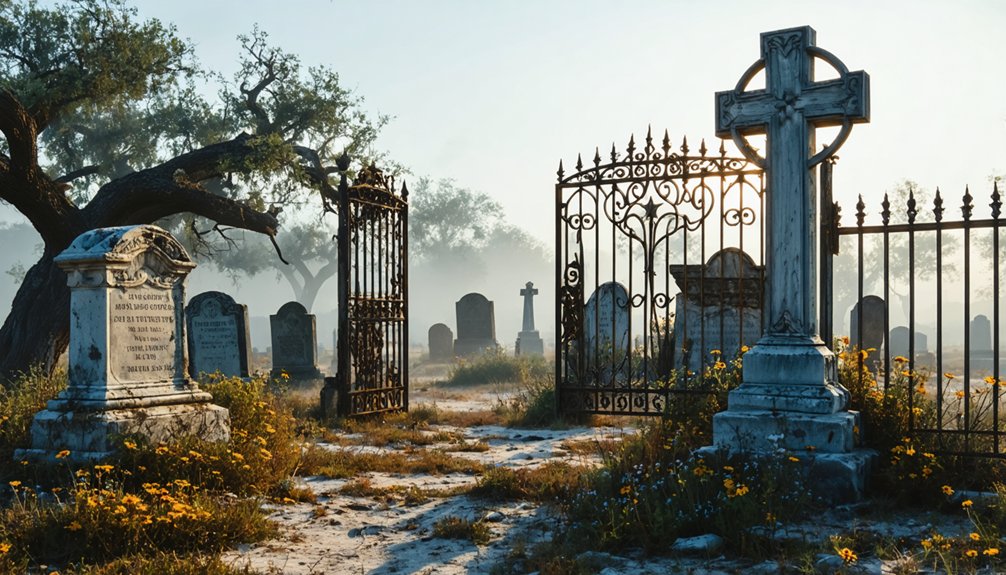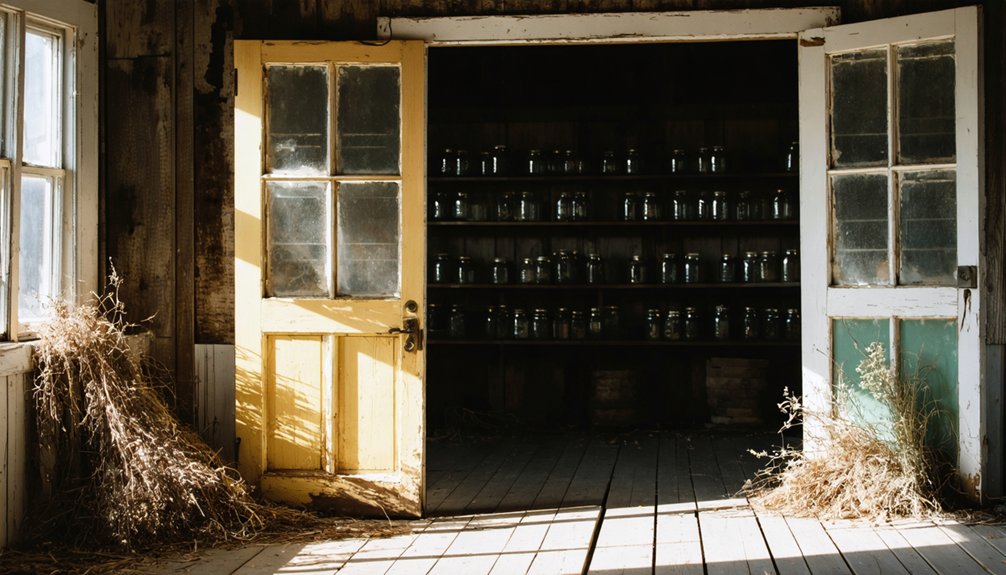You’ll find the ghost town of Olive deep in southeast Texas’s Big Thicket, where lumber operations once processed 300,000 feet of timber daily. In its 1890s heyday, this bustling company town housed 700 residents, complete with a sawmill, canning factory, and nine-mile tram system. Two devastating fires in 1903 and 1907 brought Olive’s prosperity to an end, leaving only a five-acre cemetery to tell its remarkable story of boom and bust.
Key Takeaways
- Olive, Texas was a thriving lumber town in the Big Thicket region that disappeared after devastating fires in 1903 and 1907.
- The town’s economy centered around the Sunset Sawmill, which produced 65,000 board feet of lumber daily during its peak.
- Only a five-acre cemetery remains today, serving as the last physical remnant of this once-prosperous multiethnic lumber community.
- The final log was processed in March 1912, and by 1918, Olive had disappeared from railroad maps entirely.
- At its height between 1890-1904, Olive’s population grew from 383 to 700 residents before its eventual decline.
Origins in the Big Thicket
Before settlers arrived, indigenous groups like the Caddo and Atakapa knew this land as the “Big Woods,” using its abundant resources for hunting deer and bear while avoiding its most remote depths.
Economic development drastically changed the landscape as timber cutting operations began transforming the region in the 1850s.
You’ll discover that the first European settlements, including Olive, emerged along the Thicket’s edges rather than its heart. The early pioneers built close-knit communities that maintained strong family ties and traditions passed down from their southern Appalachian roots.
It wasn’t until the 1880s, when the Sabine and East Texas Railroad cut through Hardin County, that this once-isolated wilderness began opening up to development.
The Birth of a Lumber Empire
While the Big Thicket remained largely untouched through most of the 19th century, the arrival of lumber companies in the 1880s transformed this wilderness into an industrial powerhouse.
You’d have witnessed pioneering figures like John A. Sternenberg and Sid Olive establishing operations that would reshape the region’s destiny. Like many who sought new opportunities after the Civil War, these entrepreneurs moved from their former lives to establish successful businesses in Texas after the Confederacy.
The landscape changed dramatically as lumber innovations revolutionized the industry. New sawmills emerged, backed by massive capital investments like Kirby Lumber Company‘s $10,000,000 venture in 1901. The company swiftly acquired fourteen lumber mills to establish its dominance in Texas.
Despite frequent timber disputes between workers and management, the industry created countless jobs and spurred rapid development. Railroad lines carved through the forest, connecting isolated communities to thriving lumber markets.
Towns sprouted up around these operations, complete with company stores, housing, and essential services for the growing workforce.
Life in a Sawmill Town
If you’d visited Olive’s sawmill workers in 1905, you’d have found them toiling from sunrise to sundown in hazardous conditions, handling massive pine logs up to 48 inches in diameter.
The workers, both Black and white, lived in company-provided housing centered around the Sunset Sawmill, which produced 65,000 board feet of lumber daily. Their daily meals often came from the canning factory output, as the company built a 5,000-can-per-day facility exclusively for mill workers. By 1902, this area had become part of Texas’s largest sawmill operation, producing over 300,000 feet of lumber each day.
Despite the harsh working conditions, families formed a close-knit community with schools, hotels, and social gatherings, though many workers’ poverty was evident in the unmarked graves that still dot Olive Cemetery.
Daily Mill Worker Life
Life at the Sunset Sawmill in Olive revolved around the demanding rhythms of lumber production, where 250 workers operated machinery capable of processing 65,000 board feet daily by 1889.
You’d start your day alongside fellow workers, both Black and white, tackling specialized roles from felling massive 48-inch diameter pines to manning the steam-powered saws.
Worker camaraderie developed as you’d face the hazards together – constant sawdust, deafening machinery noise, and the ever-present risk of fire. The ten-hour workdays were grueling under the supervision of a strict woods boss.
Daily routines meant working through East Texas’s humid conditions, moving logs from mill ponds and operating heavy equipment. Colonel J. A. Sternenberg was known for his exceptional hospitality toward the workers.
While the mill provided housing and some supplies, they’d deduct these from your wages.
You’d find your life intertwined with the mill’s operations, as generations of families made their living in this timber-based economy.
Housing and Living Conditions
Within the sawmill town of Olive, you’d find rows of simple wooden-frame houses built by the company, each offering basic shelter for the mill’s workforce.
You’d notice stark housing disparities, with management living in better quarters while workers, especially Blacks and immigrants, occupied smaller, less maintained homes.
Your daily life would revolve around communal facilities – shared outhouses and water sources due to limited plumbing infrastructure. Living conditions were especially difficult since towns provided essential services like medical facilities and schools for the community.
Workers earned between $1.50 to $3.00 per day depending on their skill level, which affected their ability to maintain their homes.
The harsh pine forest climate, combined with constant sawmill dust and poor insulation, would make living conditions challenging.
Your home’s upkeep would suffer from minimal maintenance, while insects and fire risks posed constant threats.
If you lost your mill job, you’d lose not just income but your housing too, highlighting the complete dependency on company provisions.
Community Social Activities
Despite the basic living conditions, social life in Olive centered around vibrant community gatherings that brought warmth to the sawmill town.
You’d find strong social bonds forming through church functions, seasonal festivals, and regular town events held in common areas near the Sunset Sawmill.
The community’s social calendar revolved around:
- After-work celebrations and informal music performances where you could enjoy dancing and storytelling
- Church-sponsored activities including Sunday school, prayer meetings, and holiday festivities
- Outdoor recreation like baseball games, fishing trips, and community picnics
The sawmill workers and their families created tight-knit support networks, helping each other through tough times.
You’d see this community spirit in action through mutual aid groups and informal assistance networks, especially when workers faced occupational hazards or economic hardships.
Railroad’s Role in Growth

As the Sabine and East Texas Railroad carved its path through Hardin County in the early 1880s, Olive emerged as an essential stopping point along the newly constructed rail lines.
You’d have witnessed remarkable railroad expansion transforming this once-isolated frontier settlement into a bustling hub of activity. The rails didn’t just connect Olive to larger Texas markets – they brought dramatic economic integration, attracting workers, businesses, and important services to the area.
You’ll find the railroad’s influence reached far beyond transportation. It sparked population growth through immigrant labor, boosted land values, and fostered the development of schools, churches, and civic organizations.
The rail lines made Olive a center for timber shipping and agricultural trade, though this prosperity wouldn’t last forever as transportation methods evolved in the 20th century.
Economic Peak and Prosperity
During its economic zenith from 1890 to 1904, Olive transformed into a thriving industrial hub anchored by the Sunset Sawmill’s massive timber operations.
You’d have witnessed remarkable population dynamics as the town grew from 383 to 700 residents, including a diverse workforce that powered the local timber economy.
The town’s prosperity rested on three key pillars:
The economic success of Olive relied on three essential foundations that fueled its remarkable industrial growth and development.
- A vast 40,000-acre timberland holding that supplied massive pine logs up to 48 inches in diameter
- An efficient 9-mile tram road system utilizing Baldwin and Shay locomotives
- A complementary agricultural sector producing fruits and vegetables
The robust economic foundation attracted both workers and businesses, creating a self-sufficient community where you’d find sawmill workers, farmers, and merchants all contributing to Olive’s golden age of industrial achievement.
The Fires That Changed Everything

You’ll find Olive’s downfall began with the catastrophic 1903 fire that destroyed the Sunset Sawmill, though the town initially managed to rebuild and continue operations.
Just four years later in 1907, a second devastating fire struck the mill, delivering what would prove to be the final blow to Olive’s primary industry.
After this second blaze, the mill never reopened, setting in motion the town’s irreversible transformation into a ghost town.
Devastating 1903 Mill Fire
When flames engulfed Olive’s primary sawmill in 1903, they sparked more than just a devastating industrial fire – they ignited the town’s irreversible decline.
The fire aftermath devastated the mill complex that had been processing 100,000 feet of logs daily, dealing a crushing blow to local industry and employment.
Despite attempts at community resilience, you’ll find three key factors that sealed Olive’s fate:
- The destruction halted all sawmilling operations, eliminating the town’s economic foundation
- Timber reserves were already depleting, making mill reconstruction impractical
- Workers and their families began abandoning company housing as jobs disappeared
Final Blaze of 1907
Though Olive’s community struggled to rebuild after the devastating 1903 fire, a second major blaze in 1907 struck the final blow to the town’s industrial heart.
You’ll find few detailed accounts of the 1907 fire in historical records, but its impact on Olive’s fate proved unmistakable. The destruction accelerated an economic collapse that was already looming due to dwindling timber reserves.
While you could still spot Olive on railroad maps until 1918, the town’s decline became inevitable after the fire. The mill processed its final log in March 1912, and families began departing the once-bustling lumber center.
Without its economic engine, company housing emptied, businesses shuttered, and by 1920, only the post office remained as a monument to Olive’s former glory.
Traces of a Lost Community
Despite its once-bustling population of 1,200 residents, Olive, Texas has virtually disappeared from the landscape, with only its five-acre cemetery remaining as tangible evidence of the former lumber town‘s existence.
The cemetery’s remarkable community resilience through natural disasters, including the 2011 brush fire, stands as a reflection of the historical significance of this forgotten settlement near modern-day US 69 and FM 1003.
If you’re searching for remnants of Olive’s past, you’ll find:
- Historic photographs showing massive pine logs on Olive’s log cars
- Railroad maps from the early 1900s marking the town’s location
- Archival documents detailing the nine-mile tram road system that once transported timber
The town’s physical traces may have vanished, but these surviving records tell the story of a thriving multiethnic lumber community.
Olive Cemetery: The Last Witness

The last physical remnant of Olive’s existence stands quietly off US 69 in Hardin County – a five-acre cemetery where weathered tombstones peek through overgrown vegetation.
You’ll find markers dating from the 1890s to early 1900s, including Johannes Paulsen’s German-inscribed gravestone enclosed by wrought iron, reflecting the town’s multicultural roots.
Despite the lack of cemetery preservation efforts, these scattered stones tell powerful stories of a once-thriving community of 976 residents.
The site has weathered hurricanes and a 2011 brush fire, yet maintains its historical significance as the sole witness to Olive’s past.
Among the forest growth, you’ll discover varied epitaphs and markers – from elaborate to simple – documenting the diverse lives of settlers who built, then abandoned, this vanished East Texas lumber town.
Tales From the Timber Era
When lumber barons discovered East Texas’s pristine pine forests in the late 1800s, Olive emerged as one of the region’s bustling timber towns.
You’d find towering pines stretching 150 feet high and 5 feet wide, an untapped wealth that transformed the local economy. The town’s sawmill, a cornerstone of the timber trade by 1879, drove Olive’s rapid expansion.
Consider these key developments that shaped Olive’s timber era:
- The mill survived a devastating fire and rebuilt, showing the town’s resilience.
- A tram system connected Olive to the broader East Texas logging network.
- The Olive Canning Factory represented attempts to diversify beyond raw lumber.
The boom wouldn’t last forever.
Like many timber towns, Olive’s prosperity faded as the virgin forests fell to intensive logging, leaving behind tangled underbrush and scattered second-growth pines.
Frequently Asked Questions
What Happened to the Mill’s Machinery After the Final Shutdown?
You’ll find that most of the mill’s machinery was sold off in 1912, though without historical preservation efforts, the remaining equipment faced machinery decay or was relocated for use elsewhere.
Were There Any Notable Crimes or Lawlessness During Olive’s Peak Years?
You won’t find crime statistics or law enforcement records showing notable lawlessness in this lumber town – while other Texas ghost towns gained notorious reputations, Olive maintained a relatively peaceful existence.
Did Any Famous People or Historical Figures Visit Olive?
You won’t find records of any famous visitors to Olive during its brief existence. Despite its historical significance as a lumber boomtown, the community didn’t attract notable figures before becoming a ghost town.
What Was the Average Wage for Sawmill Workers in Olive?
You’d find sawmill workers in early 1900s Olive earned between $1.50-$2.50 per day, working 9-11 hour shifts under harsh conditions, matching the typical wage range across Texas lumber operations.
Did Native Americans Live in or Near Olive Before Its Establishment?
You’ll find Native tribes like the Apache and Comanche historically moved through the region, though there’s no evidence of permanent settlements exactly where Olive was established. They used nearby areas for hunting.
References
- https://hauntingsinhistory.wordpress.com/2017/08/14/olive-ghost-train-kountze-texas/
- https://www.beaumontenterprise.com/photos/article/Charred-remains-of-Olive-Texas-2142696.php
- http://www.wtblock.com/olivetexas.htm
- https://en.wikipedia.org/wiki/List_of_ghost_towns_in_Texas
- https://www.texasescapes.com/WTBlock/Olive-Hardin-County-Texas.htm
- https://www.texasescapes.com/TexasHillCountryTowns/MountOliveTexas.htm
- http://www.wtblock.com/MillTownsGhostTowns.htm
- https://www.americanheritage.com/big-thicket
- https://npshistory.com/publications/bith/index.htm
- https://www.nps.gov/bith/learn/historyculture/creation-of-big-thicket-national-preserve.htm



